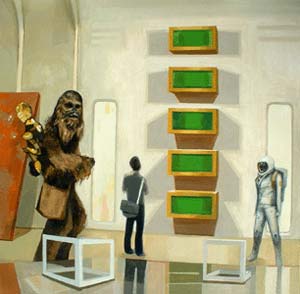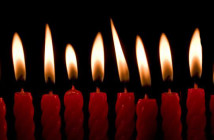In a previous issue of Big RED, I wrote about science-fiction and its role as a gauge of our current collective fears. Good sci-fi extrapolates our underlying paranoia and expands them into the future – often creating a vision of what may be to come if we don't change our ways now. In much the same way, the paintings of Scott Listfield extrapolate our underlying banalities, our daily routines, into a future both humorous and identifiable.
Listfield's paintings are infused with popular iconography, often many layers deep. Most feature a person in an astronaut suit, caught in the acts of everyday life, and the reoccurance of this character provides the work with a sense of diary, as if the astronaut is somehow a futuristic adaptation of the 'traveling gnome' of Amelie fame. Within this sort of journal, we find icons from popular films, contemporary art, advertising, and even a nod or two to visions of the future now seen as obsolete.
Listfield explains that "before I started painting the astronaut, I did self-portraits for four years. That's all I did. So I guess the astronaut is sort of a surrogate."
"in science-fiction of the past," he said, "the 50s and 60s, even the 70s and later, it was always a consistent theme that people would be astronauts in the future - not everyone, maybe - but they always seemed to be in space. And people always had robots."
In "Chewbacca in Cloud City with Art", Chewbacca stands with C-3PO disassembled on his back, from The Empire Strikes Back. On the wall hangs a famed Donald Judd sculpture, but the characters are posed not with awe and reverence for this great work of art. Instead, the astronaut watches Chewbacca pass, the mirrored face of his helmet expressionless.
The painting "At The Robot Store" shows the astronaut character browsing at a sort of Ikea for robots, standing beneath a stack of gigantic boxes labeled R2 with an iconic R2-D2 on the side, and a towering display model Transformer. In the background are boxes for other robots, including the famous design from TV's Lost In Space. It is all presented so calmly, as if shopping for a robot is not a fantastic endeavor but the sort of average family purchase one might make at Sears.
"I was in Costco one day," Listfield says of this painting, "and I just thought to myself What if this were the future, and I needed to buy a robot? You never really see characters in science-fiction buying their robots. They just have them. I guess in Star Wars they go to that junk ship to buy robots, but where do they get new ones?"
One of the great surprises of the show is "A Visit To Black Mountain", which features the astronaut and a friend riding horses in the mountains. At the top of one alpine peak sits Space Mountain, presumably their destination. This play on words made me laugh out loud, and caused me to question something that, for my whole life, I have left unchallenged: Why is it called Space Mountain? Who, in their right mind, stuck those two words together when trying to describe this bland bucky-ball of a tourist trap?
Seemingly the most simple image in the show is "To The Moon", in which the astronaut is attempting to flag down a city bus. On the front of the bus, the illuminated LED screen displays the destination: The Moon. For me, this is the image that has remained the most interesting long after having seen the show.
What is it about the idea that a person dressed as an astronaut could just step up to the curb and flag a bus to the moon? Is it the dream of visiting another planet, or the fantasy of being an astronaut? I think not. What is most interesting about this image is the suggestion that such things could someday be so easy, that catching a ride to Copley Square would require the same amount of effort as going to the moon. Listfield's future is not one of fantastic devices and stylized gadgets, but merely our contemporary life updated. Buses, cars and boats still dominate our travel, and even the act of bringing a robot into our life is really just as banal as buying a new toaster or washing machine.
Since viewing this show, I have heard more than one person refer to these paintings as 'one-liners', implying that their inherent humor and obvious references make them easy to dismiss. However, having spent the last month revisiting them in my mind, and re-laughing and re-pondering their narratives, I would have to disagree. Much like any good storytelling, these paintings are easily read and have a pop-friendly point-of-entry, but just because they are humorous does not make them 'one-liners'. On the contrary, their depth comes from their seeming simplicity: they depict banal acts and common-place situations with a twist. They are one man's diary of his journeys into the future invented by pop culture, and what he has brought back is a vision perhaps more startling than Alien or Blade Runner – that the future is (more or less) now.
Links:
Locco Ritoro Gallery
Scott Listfield - AstronautDinosaur.com
"Scott Listfield: Astronaut" is on view at Locco Ritoro Gallery.
All images are courtesy of the artist and Locco Ritoro Gallery.
Matthew Nash is the publisher of Big, Red & Shiny.



